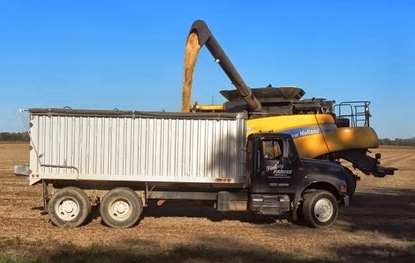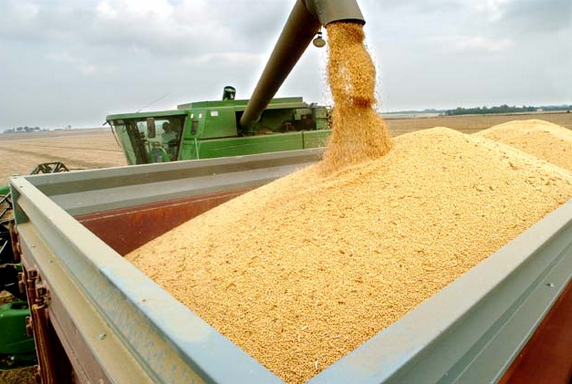New Study Suggests Changes for Heavier Semis on Nation’s Roads
A new study from the Soy Transportation Coalition (STC), “Heavier Semis: A Good Idea?” –analyzes the likely results of expanding semi weight limits over the federal highway system and makes specific recommendations.
Funded by the soybean checkoff, it is an update of an earlier 2009 report that analyzes the impact of increasing semi weight limits on federal roads and bridges from an 80,000 lbs., five axle configuration to a 97,000 lbs., six axle configuration on:
1.) Motorist safety;
2.) Infrastructure wear and tear; and
3.) Potential cost savings and efficiency gains for agriculture and the U.S. economy.
According to the U.S. Department of Transportation, the volume of freight demand by all modes of transportation – truck, rail, maritime, and air – is expected to increase from 18.5 billion tons in 2010 to more than 27.5 billion tons in 2040 – a 48 percent increase. What’s more, demand for trucking is expected to increase from 12.5 billion tons in 2010 to 18.5 billion in 2040 – an increase of 6 billion tons or 67 percent of the total growth in freight demand.
According to the authors, “While demand for trucking continues to increase, trucking capacity has been challenged by insufficient investment in road and bridge capacity, a widespread and persistent shortage of truck drivers, and recent declines in rail service that have required trucks to accommodate more freight.”
“Demand for trucking is projected to increase, but supply of trucking is not keeping pace,” says Scott Gauslow, a soybean farmer from Colfax, North Dakota, and chairman of the Soy Transportation Coalition. “It is therefore important to explore opportunities to increase trucking capacity without endangering fellow motorists or damaging our roads and bridges.”
The study highlights that adding an additional sixth axle to a semi weighing 97,000 lbs. will create additional braking capacity so that stopping distances will be the same as a five axle, 80,000 lbs. truck.
Moreover, allowing six axle, 97,000 lbs. semis will result in fewer semis on the road compared to maintaining an 80,000 lbs. weight limit, which will result in fewer accidents and injuries. The study projects such an approach will result in 98 fewer motorist fatalities by 2022.
 “Motorist safety is more of a function of the number of semis on the road and less a function of the weight of individual semis,” explains Mike Steenhoek, executive director of the Soy Transportation Coalition. “We can respond to the increased demand for trucking by either maintaining the status quo, which will result in a higher density of semis per mile, or entertaining options such as allowing six axle, 97,000 lbs. semis. The research indicates such an increase in semi weight limits will lower the potential for injuries and fatalities – providing a safer system for fellow motorists.”
“Motorist safety is more of a function of the number of semis on the road and less a function of the weight of individual semis,” explains Mike Steenhoek, executive director of the Soy Transportation Coalition. “We can respond to the increased demand for trucking by either maintaining the status quo, which will result in a higher density of semis per mile, or entertaining options such as allowing six axle, 97,000 lbs. semis. The research indicates such an increase in semi weight limits will lower the potential for injuries and fatalities – providing a safer system for fellow motorists.”
The study further highlights how a six axle, 97,000 lbs. semi will result in a reduction of weight per tire of 35 lbs. compared to a five axle, 80,000 lbs. semi – reducing wear and tear on the nation’s roads. For transporting soybeans and soy products, allowing six axle, 97,000 lbs. semis will result in 1.2 million fewer truck trips, 5.5 million fewer gallons of fuel consumed, 56 thousand fewer tons of carbon dioxide emissions, and between $11 million – $28 million in reduced fuel costs.
The use of a six axle, 97,000 lbs. semi will enable a farmer to transport at minimum an additional 183 bushels of soybeans per load. By 2022, this will annually save soybean farmers 602,000 truck trips, 1.7 million gallons of fuel, and between $4 million – $8 million in reduced fuel costs.
“While increasing semi weight limits clearly would result in greater efficiency of moving agricultural products, farmers are also concerned with motorist safety and the quality of the road system,” says Gauslow. “In reality, those living in rural areas often experience a greater probability of encountering heavy semis than those living in urban areas. The last thing farmers would want to promote is a system that would result in greater danger to themselves and their families and greater damage to the transportation system they depend on. We therefore believe farmers have a lot of credibility on this important issue.”
Category: Featured, General Update, Management











